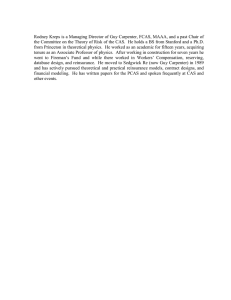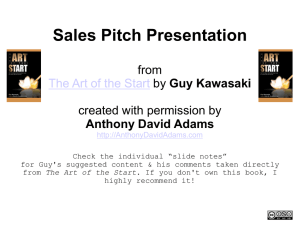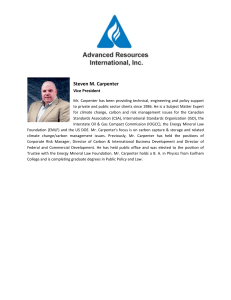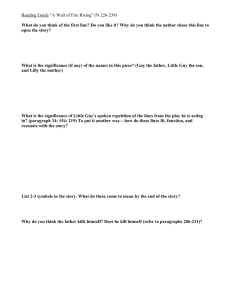Crop Insurance Overview of Primary Market in US June 6-7, 2005 Susan Witcraft
advertisement
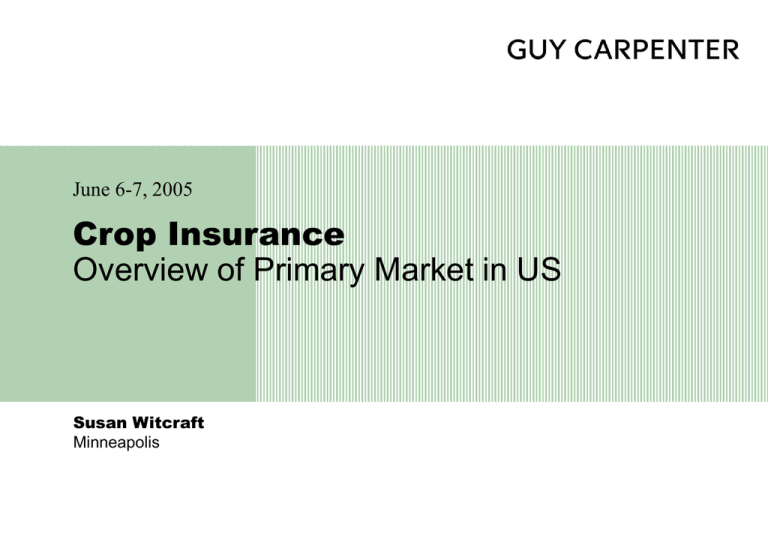
June 6-7, 2005 Crop Insurance Overview of Primary Market in US Susan Witcraft Minneapolis U.S. Crop Insurance Three Classes of Business MPCI (Multiple Peril Crop Insurance) Government supported program. Rates, policy forms, underwriting guidelines and loss adjusting procedures are all established by the Federal Crop Insurance Corporation (FCIC). FCIC offers attractive inuring reinsurance protections. The Policy is “Yield” or “Revenue” based covering “All Perils”. Crop Hail Traditional crop insurance that has been around since the early 1900’s. Policy covers only Hail and Allied Coverages. Policy structured as a “percentage of insured value” basis. Named Peril Single peril coverage on specific crops or MPCI Add On / Deductible Protection. Guy Carpenter 2 Crop Insurance Industry 2004 Gross Premium Breakdown Estimate Named Peril $15M MPCI Guy Carpenter Crop Hail $427M $4.2B 3 MPCI Multiple Peril Crop Insurance (MPCI) Loss Breakdown by Peril 1981 - 2004 Other 15% Disease 4% Heat 4% Disease Freeze 5% Heat Freeze Excess Moisture Hail Drought Other Excess Moisture 24% Drought 40% Guy Carpenter Hail 8% 5 MPCI Industry Overview Definitions of Coverage Types “Buy Up” This is a production or yield based policy. This traditional type coverage utilizes a farmer’s deductible level and individual Actual Production History (APH – 6- to 10year average yield) to determine coverage. The farmer chooses a coverage level (ranging from 50% - 90%) and price election when buying a policy. Catastrophe This is also a production or yield based policy. This coverage was introduced by the FCIC in 1995 after the 1993 MPCI loss as a further “subsidy” to the market. The policy offers 50% coverage at 60% of the MPCI price election. Guy Carpenter 6 MPCI Industry Overview Definitions of Coverage Types “Buy-Up” Insurance Example (Iowa Corn) Individual Farmer APH Year APH 1993 80 1994 125 1995 150 1996 150 1997 145 1998 140 1999 130 2000 120 2001 60 2002 100 Average APH 120 Guy Carpenter 2003 Purchased Policy MPCI Level 70% Price Election 2.40 Amount of Insurance:$201.60 2003 Payout 2003 Actual Production: 75 Payout: 120 (APH) * 70% (Coverage Level) = 84 84 - 75 (2003 Yield) = 9 bushel loss per acre 9 * $2.40 (price election) = $21.60 Insurance loss payment per acre 7 Industry Overview Definitions of MPCI Coverage Types Revenue (CRC or RA) This is a revenue protection policy. This coverage was first introduced to the market in 1996 for corn and soybeans in the states of Iowa and Nebraska. The FCIC has expanded this coverage for other crops and in nearly all states. The revenue coverage guarantee is determined using the farmers APH and Chicago Board of Trade (CBOT) commodity prices. CRC Insurance Example CRC Policy Wording Definitions Minimum Guarantee - APH multiplied by the Base Price multiplied by the coverage level elected. Harvest Guarantee - APH multiplied by the Harvest Price multiplied by the coverage level elected. Final Guarantee - Greater of the Minimum or Harvest Guarantee. Assumptions APH = 150 CBOT Price = $2.50 Coverage Level = 70% Minimum Guarantee = $262.50 Guy Carpenter 8 Industry Overview Definitions of MPCI Coverage Types CRC Insurance Example Example 1 - “2002 Type Scenario” - Yield CBOT price Actual Yield 80 Minimum Guarantee $262.50 Harvest Price $2.75 Harvest Guarantee $288.75 Final Guarantee $288.75 Actual Revenue* $220.00 $ Loss Per Acre $68.75 Example 2 - “2001 Type Scenario in Nebraska” - Yield CBOT price Actual Yield 80 Minimum Guarantee $262.50 Harvest Price $2.25 Harvest Guarantee $236.25 Final Guarantee $262.50 Actual Revenue* $180.00 $ Loss Per Acre $82.50 * Current Yield multiplied by Harvest Price Guy Carpenter 9 Industry Overview Definitions of MPCI Coverage Types CRC Insurance Example Example 3 - “1994 Type Scenario” - Yield CBOT price Actual Yield 175 Minimum Guarantee $262.50 Harvest Price $2.25 Harvest Guarantee $236.25 Final Guarantee $262.50 Actual Revenue* $393.75 $ Loss Per Acre $0 Actual Revenue* $481.25 $ Loss Per Acre $0 Example 4 - Yield CBOT price Actual Yield 175 Minimum Guarantee $262.50 Harvest Price $2.75 Harvest Guarantee $288.75 Final Guarantee $288.75 * Current Yield multiplied by Harvest Price Guy Carpenter 10 MPCI Historical Perspective – “Late 1990’s” $4,500,000,000 • Crop Insurance Reform and 1996 Farm bill spurred MPCI sales. FCIC ceased to deliver the MPCI product under bill. • Increased premium subsidy for farmers in 1999 • Introduction of Revenue products in 1996. $4,000,000,000 $3,500,000,000 $3,000,000,000 $2,500,000,000 $2,000,000,000 $1,500,000,000 $1,000,000,000 Guy Carpenter 11 2004 2003 2002 2001 2000 1999 1998 1997 1996 1995 1994 1993 1992 1991 1990 1989 1988 1987 1986 1985 1984 1983 1982 $0 1981 $500,000,000 MPCI 2004 Industry Gross Premium by State AK VT WA MT ME ND MA MN OR ID NY WI SD RI MI CT WY PA IA NE NV IL IN WV CO KS NJ OH UT CA NH MO DE VA KY MD NC TN AZ OK NM AR SC MS TX $0 to $25M $25M to $50M $50M to $100M Greater than $100M AL GA LA FL HI Guy Carpenter 12 MPCI Standard Reinsurance Agreement (SRA) SRA - a Contract between the Government (FCIC) and the private insurance company. Proportional and non proportional reinsurances available. The SRA allows ceding companies to cede or designate each crop contract (policy) to one of the following seven funds: – Assigned Risk – Developmental – Cat – Developmental – Buy-up – Developmental – Revenue – Commercial – Cat – Commercial – Buy-up – Commercial – Revenue Ceding companies utilize historical experience, market knowledge and underwriting models to determine the business they wish to retain and the undesirable business they wish to cede to the FCIC. Guy Carpenter 13 Standard Reinsurance Agreement Proportional Reinsurance – A Assigned Risk Fund – Company’s less desirable business - “Social Fund”. – FCIC sets cession limits by state, based on loss history. – 75%-85% of the business is proportionately ceded to FCIC. Developmental Fund – Accommodates business where “uncertainty” exists or where Assigned Risk limits are exceeded. – Up to 65% of gross premiums can be ceded to FCIC. Commercial Fund – Accommodates a Company’s most profitable business. – Highest profit potential and highest risk potential. – Up to 50% of gross premiums can be ceded to FCIC. Guy Carpenter 14 Standard Reinsurance Agreement Non Proportional Reinsurance 94% 94% 100% 90% 70% 75% 70% 80% 57% 70% 60% 60% 50% 50% 50% 60% 50% Loss Ratio Layer Guy Carpenter Unl x 500% 50% x 0% 0% 280% x 200% 10% 60% x 160% 20% 60% x 100% 30% 30% 11% 17% 30%11% 17% 23% 17% 25% 8% 25% 20% 6% 0% 20% Commercial Revenue 11% 6% 0% Commercial Buy-Up 11% 0% 4%9% 15% Commercial Cat 11% 0% Developmental Revenue 2% 5% 0% Developmental Buy-Up 4% Fund 0% Developmental Cat 2% 0% Assigned Risk 35% x 65% 40% 43% 40% 40% 45% 15% x 50% Participation 50% 50% 15 Standard Reinsurance Agreement Non Proportional Reinsurance 60.00% 48.90% 31.50% 40.00% 20.00% 48.90% 7.60% 31.50% 37.75% Maximum Net Loss By State 22.50% 0.00% Maximum Net Gains By State -20.00% -11.00% -40.00% -60.00% -57.80% -57.80% -62.30% -80.00% -100.00% -101.60% -101.60% -107.60% -120.00% Assigned Risk Commercial - Buy-up Guy Carpenter Developmental - Buy-up Commercial - Cat Developmental - Cat Commercial - Revenue Developmental - Revenue 16 Net Gain/Loss Standard Reinsurance Agreement Effect on Net Gain/Loss of Non Proportional Reinsurance 50% 40% 30% 20% 10% 0% -10% -20% -30% -40% -50% -60% -70% -80% -90% -100% -110% 0% 50% 100% 150% 200% 250% 300% 350% 400% 450% 500% Gross Loss Ratio Commercial Revenue Developmental Cat/Buy-Up Guy Carpenter Commercial Cat/Buy-Up Assigned Risk Developmental Revenue 17 Standard Reinsurance Agreement Proportional Reinsurance – B FCIC assumes a 5% share of the total gain or loss of a Company’s book of business. Provision first introduced for the 2005 crop season. Due to the profitable nature of the business, this provision is the Government’s way of reducing their cost to service and manage the MPCI Program. Guy Carpenter 18 SRA Gross U/W Gain Calculation Examples Assigned Risk Developmental (Buy-up) Commercial (Buy-up) Total Gross Premium (000's) Gross Premium (000's) Gross Loss (000's) Gross LR Gross Premium (000's) Gross Loss (000's) Gross LR Gross Premium (000's) Gross Loss (000's) Gross LR Gross Premium (000's) Gross Loss (000's) Gross LR MN $2,000 $200 $320 160% $0 $0 0% $1,800 $900 50% $2,000 $1,220 61% IA $2,000 $100 $100 100% $200 $130 65% $1,700 $1,105 65% $2,000 $1,335 67% CA $4,000 $500 $500 100% $500 $1,100 220% $3,000 $3,000 100% $4,000 $4,600 115% TX $7,000 $3,000 $6,600 220% $2,000 $2,000 100% $2,000 $1,300 65% $7,000 $9,900 141% $15,000 $3,800 $7,520 198% $2,700 $3,230 120% $8,500 $6,305 74% $15,000 $17,055 114% State Total Guy Carpenter 19 SRA Net U/W Gain Calculation Examples “After Proportional Cessions” Assigned Risk Net Premium Net Loss State (000's) (000's) Net LR Developmental Buy-up Net Premium (000's) Commercial Buy-up Net Net Loss Premium Net Loss (000's) Net LR (000's) (000's) Net LR Total Net Premium Net Loss (000's) (000's) Net LR MN $50 $80 160% $0 (1) $0 0% $1,800 $900 50% $1,850 $980 53% IA $25 $25 100% $200 (1) $130 65% $1,700 $1,105 65% $1,925 $1,260 65% CA $65 $65 100% $500 (1) $1,100 220% $3,000 $3,000 100% $3,565 $4,165 117% TX $450 $990 220% $700 (2) $700 100% $2,000 $1,300 65% $3,150 $2,990 95% Total $590 $1,160 197% $1,930 138% $8,500 $6,305 74% $10,490 $9,395 90% $1,400 (1) 100% Retained (2) 35% Retained Guy Carpenter Overall Loss Ratio Goes Down with Proportional Cessions 20 SRA Net U/W Gain Calculation Examples “After Non-Proportional Cessions” Assigned Risk Net U/W Premium Gain/Loss State (000's) (000's) Net L/R Developmental Buy-up Net Premium (000's) Commercial Buy-up Total U/W Net U/W U/W Gain/Loss Premium Gain/Loss Net PremiumGain/Loss (000's) Net L/R (000's) (000's) Net L/R (000's) (000's) Net L/R MN $50 ($2) 103% $0 $0 100% $1,800 $781 57% $1,850 $780 58% IA $25 $0 100% $200 $42 79% $1,700 $559 67% $1,925 $601 69% CA $65 $0 100% $500 ($135) 127% $3,000 $0 100% $3,565 ($135) 104% TX $450 ($24) 105% $700 $0 100% $2,000 $658 67% $3,150 $634 80% Total $590 ($26) 104% $1,400 ($93) 113% $8,500 $1,999 24% $10,490 $1,880 82% Total U/W Gain 18% Overall Loss Ratio Goes Down Further with NonProportional Cessions Guy Carpenter 21 MPCI Historical Industry Underwriting Results Year 1989 1990 1991 1992 1993 1994 1995 1996 1997 1998 1999 2000 2001 2002 2003 2004 Total Gross Premium $722,262,045 744,751,547 656,071,552 694,514,965 702,430,420 919,637,263 1,270,326,512 1,627,091,008 1,689,202,256 1,875,995,690 2,312,374,790 2,536,402,462 2,977,930,337 2,911,424,789 3,436,731,510 4,185,369,786 $29,262,516,932 Net Retained Premium $352,456,663 408,584,026 445,059,562 465,872,117 434,847,472 536,602,513 768,499,418 1,155,072,581 1,263,143,481 1,591,730,382 1,836,870,180 1,893,524,050 2,372,197,462 2,294,612,548 2,606,792,668 3,139,784,617 $21,565,649,740 Underwriting Gain / Loss $ % $28,892,316 8.20% 51,134,007 12.51% 41,309,936 9.28% 21,811,739 4.68% (83,326,250) -19.16% 103,270,641 19.25% 132,302,113 17.22% 247,571,252 21.43% 352,070,977 27.87% 279,208,820 17.54% 271,756,850 14.79% 285,017,991 15.05% 349,821,584 14.75% (36,262,528) -1.58% 388,026,833 14.89% 549,462,308 17.50% * $2,982,068,589 13.83% *Estimated Guy Carpenter 22 MPCI Expenses FCIC A&O Reimbursement Summary 40.0% 34.0% 35.0% 32.5% 31.0% 30.0% 27.5% 25.0% 22.0% 22.0% 22.0% 22.0% 22.0% 1999 2001 2002 2003 2004 20.0% 15.0% 10.0% 5.0% 0.0% 1991 1993 1995 1997 • Continued reduction in the A&O has put many companies in an operational deficit position between 2 -10% of Net Retained Premiums. Guy Carpenter 23 MPCI Cash Flow Example Iowa Farmer Insurance Company / MGA / Agent Operating Account Premium Collections from Insured Monthly settlements with FCIC A & O Expense Reimbursement Premium Due FCIC • Funds most of the transactions like payments for agent commissions, LAE, etc. • Settlement on 3/31 of following year of U/W gain/loss from FCIC Needs to purchase MPCI Policy to protect Corn by no later than March 15th for crops planted in Summer of previous season through Spring of current season Escrow Account FCIC Losses Premium FCIC Insurance Company Guy Carpenter / Reinsurer Guy Carpenter • In the name of FCIC to fund claim payment requests • FCIC funds account within 3 days of receiving certified claim • Insurance Company funds their own claim payment account from escrow to pay the Farmer Reinsurance contract runs from 1/1 to 12/31 of current year and protects U/W after SRA for crops planted through 3/15 of current year. Single premium/loss transaction within 30 24 days after settlement with FCIC Crop Hail Guy Carpenter 25 Industry Growth Historical Perspective Crop Hail Industry Historical Premium 700,000,000 600,000,000 500,000,000 400,000,000 300,000,000 200,000,000 • • • 2004 2003 2002 2001 2000 1999 1998 1997 1996 1995 1994 1993 1992 1991 1990 1989 0 1988 100,000,000 Prior to the advent of the Multi-Peril Crop Insurance, Farmers managed their agricultural risk through Crop Hail coverages and various disaster relief programs. With the increased popularity of CRC coverages, and higher MPCI subsidies to the Farmer, Crop Hail insurance products started to decline as a risk management tool. With the profitability of MPCI business, ceding companies targeted growth in the MPCI class by offering agents more competitive hail products. Guy Carpenter 26 Crop Hail 2004 Industry Premium by State VT WA MT ME ND MA MN OR ID NY WI SD RI MI CT WY PA IA NE NV IL CO IN DE WV KS NJ OH UT CA NH MO VA KY MD NC TN AZ OK NM AR SC MS $0 to $1M $1M to $5M $5M to $10M Greater than $10M Guy Carpenter TX AL GA LA FL 27 Crop Hail Historical Industry Premium and Loss Ratios Year Premium Loss Ratio Year Premium 1988 362,842,000 36% 1996 630,965,000 72% 1989 374,948,000 55% 1997 594,026,000 57% 1990 410,681,000 77% 1998 576,464,000 83% 1991 412,480,000 61% 1999 508,108,000 76% 1992 423,054,000 110% 2000 468,405,000 68% 1993 486,958,000 81% 2001 433,743,000 69% 1994 515,819,000 87% 2002 405,003,000 70% 1995 531,409,000 58% 2003 422,216,000 56% 2004 427,694,000 57% Guy Carpenter Loss Ratio 28 June 6-7, 2005 Crop Insurance Overview of Primary Market in US Susan Witcraft Minneapolis
